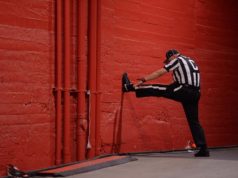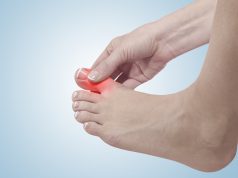You’ve been told time and again to have an on-point warm up routine before every game. Makes sense, right? You want to be properly tuned up to get ready for the demands of the game. But, what a lot of officials don’t know is that it’s equally important to give your body a chance to truly wind down after you’ve pushed it to its limits.
Depending on your sport, you may run around just as much as the players in your game do, so it’s crucial that you treat your body as well as the greats would. With the right one in place, a great post-game routine will help your body recover even faster than if you didn’t have one. That alone is reason enough to do it!
Whether you want to improve your post-game routine, or if you don’t have one at all and aren’t sure where to start, here are some tips to get you thinking about crafting your perfect post-game session.
Don’t be a bump-on-a-log after the game
Active recovery after your game is imperative.
The worst thing you can do is stop moving. Yes, your game may last up to three hours. There probably were very few breaks in between. You’re tired, I understand – but you were built for this!
You’ve (hopefully) trained for this. If treated right, your body is capable of enduring strain and pressure that will only make it stronger, especially if you give it the best chance to recover properly. It will improve under pressure. Don’t let that scare you off from (safely) cooling down with the right movement.
If you’ve ever woken up the day after a game stiff and sore, know that having an active post-game routine will help lessen and possibly even prevent that from happening. In the way that dynamic stretching is one of the best things you can do in a warm up, staying dynamic with your post-game routine can help with recovery and restoration of your muscles.
What can you do? Hit the field and run around it at least twice. You don’t have to take off in a full antelope-like sprint, nor should you be casually trotting. Simply jogging is enough. By moving at a reasonable rate, you’re reducing muscle fatigue (aka: less soreness potential the next day).
Stretch, stretch again and roll
Maintaining flexibility is important for your in-game performance, but stretching and using a foam roller after your game is a very effective method to relieve some of your muscle tension, especially if you felt you were tightening-up during the game. You will need to release any built-up tension in your joints as well, so combining stretching with about 5-10 minutes of foam rolling will have your muscles singing their way to better results 6 and relaxation.
Not sure where to start? Many complain of sore hips and hamstrings, so focus on gentle rolling with not too much pressure on the backs of your legs and the sides of your hips. A little goes a very long way, so just a few minutes is all it takes to release any tension in these trouble-zones and also help prevent further soreness from building up over the next 24 hours.
Chill out
If the sound of getting doused in cold water is attractive after a game, you’re not alone. It’s natural to want to cool your body down after a lot of activity, but there’s actually science behind utilizing ice baths in your post-game routine.
It works for the same reason putting an ice pack on a bump injury works – you want to reduce inflammation at the injury zone and, minimize pain.
Though opinions vary about how long someone should undergo “cold water immersion therapy” or “ cryotherapy” , the general consensus seems to be that putting yourself in an ice bath between 10-14 minutes at 54F-57F degrees is more than enough to treat and relieve soreness.
The first few minutes are the most difficult, but once you get used to it, you’ll find relief coming to sore or stiff areas.
However, if you don’t want to sit in an ice bath, then “Contrast Water Therapy” is another very viable option.
Contrast Water Therapy is essentially alternating between immersing yourself in cold water and warm water. And it has been shown to have tremendous restorative properties as it helps your body slough away metabolic waste from your exercise.
When you put cold water on your body, your blood vessels constrict and then re-enlarge when you warm up again. This process alone helps your body push out the metabolic waste through your lymphatic system.
How to do “CWT” at home? Try to stay in cold water (45F-59F degreest) for at least 1 minute and then switch to warm water (96F-113F degrees) for the same amount of time. 8 If you’re able, repeat this process a couple times. Just stay attuned to how you’re feeling. You can increase or decrease the length of this therapeutic time depending on whether it makes you feel better or if you’ve had enough.
References
1. O’Connor, Anahad. “The Workout: A Ref Keeps Up With March Madness.” The New York Times.
27 Mar, 2014.
2. Bird, S.P. “Sleep, Recovery, and Athletic Performance: A Brief Review and Recommendations.”
Strength and Conditioning Journal. Oct 2013.
Journal of Sports Medicine and Physical Fitness. Jun 2014.
4. Torres, Rui., et al. “Effects of Single Bout Versus Repeated Bouts Stretching on Muscle Recovery
Following Eccentric Exercise.” Journal of Science and Medicine in Sport. Nov 2013.
5. Fox, Kit. “The Running Resume of a World Cup Soccer Referee.”
Runner’s World. 15 June 2018.
Human Kinetics Journals, 2014.
Journal of Science and Medicine in Sport. 2010.
Public Library of Science. 23 Apr, 2013.
9. The Lymph System, U.S National Library of Medicine, MedlinePlus
What's Your Call? Leave a Comment:
Note: This article is archival in nature. Rules, interpretations, mechanics, philosophies and other information may or may not be correct for the current year.
This article is the copyright of ©Referee Enterprises, Inc., and may not be republished in whole or in part online, in print or in any capacity without expressed written permission from Referee. The article is made available for educational use by individuals.


















